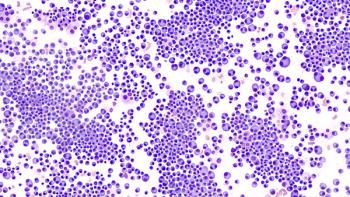
Relacorilant Combo Boosts PFS in Resistant Ovarian Cancer
Relacorilant plus nab-paclitaxel improved PFS and showed a trend toward longer OS in platinum-resistant ovarian cancer in ROSELLA.
Relacorilant in combination with nab-paclitaxel (Abraxane) significantly improved progression-free survival (PFS) and showed a favorable trend in overall survival (OS) compared with nab-paclitaxel alone in patients with platinum-resistant ovarian cancer, according to phase 3 ROSELLA trial results (NCT05257408) presented at the
Data, which were simultaneously published in The Lancet,2 showed that the median PFS via blinded independent central review (BICR) was 6.54 months (95% CI, 5.55-7.43) with relacorilant and nab-paclitaxel (n = 188) compared with 5.52 months (95% CI, 3.94-5.88) with nab-paclitaxel alone (n = 193), leading to a 30% reduction in the risk of disease progression or death (HR, 0.70; 95% CI, 0.54-0.91; P = .0076). The 6-month PFS rates were 52% and 42%, respectively, with relacorilant and nab-paclitaxel alone; the 1-year PFS rates were 25% and 13%, respectively.
Interim data for OS, which was at 50% maturity, showed that the median OS was 15.97 months (95% CI, 13.47-not reached [NR]) with relacorilant vs 11.50 months (95% CI, 10.02-13.57) with nab-paclitaxel alone, which was reported as clinically meaningful (HR, 0.69; 95% CI, 0.52-0.92; P = .0121). The 1-year OS rates were 60% and 49%, respectively.
“Relacorilant’s primary end point of PFS by blinded central review was met; the median survival was clinically meaningful, extended by approximately 5 months,” lead study author Alexander B. Olawaiye, MD, professor in the Department of Obstetrics, Gynecology & Reproductive Sciences at the University of Pittsburgh School of Medicine and UPMC Magee-Women’s Hospital, Gynecologic Oncology Group in Pittsburgh, Pennsylvania, said in an oral presentation of the data. “It is a well-tolerated regimen, and we believe it should be a new standard for platinum-resistant ovarian cancer therapy.”
The estimated survival for patients with platinum-resistant ovarian cancer is 1 year, necessitating a need for new therapies. The glucocorticoid receptor (GR) is expressed in ovarian cancer and signifies a poor prognosis. Relacorilant is a novel, selective GR antagonist that restores cancer sensitivity to cytotoxic chemotherapy. Earlier phase findings of the agent combined with nab-paclitaxel in advanced solid tumors demonstrated a disease control rate of 38%3 and an extension of PFS (HR, 0.66; P = .038). A trend of improved OS (HR, 0.67; P = .066) was also reported in a phase 2 trial of platinum-resistant ovarian cancer.4
In the multicenter open-label, randomized ROSELLA trial, patients enrolled across 117 sites in 14 countries. Patients had to have epithelial ovarian, primary peritoneal, or fallopian tube cancer; an ECOG performance status of 0 or 1; disease progression within 6 months after the last dose of platinum therapy, excluding no response to or progression within 1 month of primary platinum-based therapy; 1 to 3 prior lines of treatment; and prior bevacizumab (Avastin).
They were randomly assigned 1:1 to intravenous (IV) nab-paclitaxel at 80 mg/m2 on days 1, 8, 15, and 28 combined with oral relacorilant at 150 mg, which was given the day before, the day of, and the day after nab-paclitaxel treatment; or IV nab-paclitaxel alone at 100 mg/m2 on days 1, 8, 15, and 28. Treatment was given until disease progression or unacceptable toxicity. Stratification factors included prior lines of therapy (1 vs >1) and region (North America vs Europe vs Korea, Australia, and Latin America).
The coprimary end points included PFS by RECIST 1.1 criteria per BICR and OS. Secondary outcome measures were investigator-assessed PFS by RECIST 1.1 criteria, objective response rate (ORR), duration of response, and clinical benefit rate ([CBR]; all by RECIST 1.1 criteria), response via CA-125 Gynecologic Cancer Intergroup criteria, combined response of both criteria, and safety.
The data cutoff date was February 24, 2025. Baseline characteristics were well balanced between the 2 arms. The median age was 61.5 years (range, 26-86), with most patients identified as White (71.1%) and from Europe (56.7%). A total 8.7% of patients were Hispanic, 30.4% had an ECOG performance status of 1, and 12.3% had a BRCA1/2 mutation. Between the 2 arms, 6.8% of patients were refractory to their primary platinum therapy and 39.1% had at least 1 prior line of therapy in the platinum-resistant setting; 4.0% of these in that setting included a taxane. Besides bevacizumab, prior therapies given overall included taxanes (99.5%), pegylated liposomal doxorubicin (64.6%), and a PARP inhibitor (61.4%).
Additional efficacy data showed that the investigator-assessed median PFS also favored relacorilant, with a HR of 0.71 (P = .0030). The PFS and OS benefits with relacorilant were observed across all prespecified subgroups, except for PFS in patients with BRCA1/2-mutant disease (HR, 1.08; 95% CI, 0.49-2.37). The survival benefits with relacorilant were notable in those with high-risk disease, including those with 3 prior lines of therapy (PFS HR, 0.71; OS HR, 0.66), prior receipt of a PARP inhibitor (PFS HR, 0.60; OS HR, 0.77), primary platinum-free interval within 6 months (PFS HR, 0.50; OS HR, 0.52), and target lesions 5 cm or larger (PFS HR, 0.50; OS HR, 0.58).
The ORR with relacorilant was 36.9% compared with 30.1% in the nab-paclitaxel–alone arm (P = .17). In the relacorilant group, this comprised a 3.2% complete response rate and a 33.7% partial response rate; the stable disease, progressive disease, and not evaluable rates were 41.2%, 17.1%, and 4.8%, respectively. In the chemotherapy-alone group, these rates were 2.1%, 28.0%, 35.2%, 26.9%, and 7.8%, respectively. The clinical benefit rates were 51.1% with relacorilant/nab-paclitaxel compared with 38.9% with nab-paclitaxel alone, demonstrating a 12.2% improvement (P = .016).
Regarding safety, there was a lower unadjusted incidence of ascites with the combination (any-grade, 5%; grade ≥3, 3%) over nab-paclitaxel alone (11%; 5%). Abdominal paracenteses occurred in 7.4% of relacorilant-treated patients vs 13.2% of those on nab-paclitaxel.
The mean weeks of nab-paclitaxel therapy was longer in the relacorilant arm at 23.2 weeks (range, 0.1-90.3) vs 18.6 weeks (range, 0.1-68.1) in the monotherapy arm. All but 1 patient in the overall population experienced treatment-emergent adverse effects (TEAEs); grade 3 or higher adverse effects (AEs) occurred in 74.5% of patients on relacorilant and in 59.5% of those on nab-paclitaxel alone; serious AEs occurred in 35.1% and 23.7% of patients, respectively. A total 5.3% and 4.3% of patients on relacorilant and nab-paclitaxel alone, respectively, died on or within 30 days of last treatment dose.
There were 6.9% of patients who had dose reductions due to TEAEs with relacorilant; dose reduction rates with nab-paclitaxel occurred in 48.4% and 31.6% of patients on the relacorilant and nab-paclitaxel arms, respectively. A total 72.9% and 54.7% of patients, respectively, had dose interruptions of treatment due to TEAEs; treatment discontinuations occurred in 9.0% and 7.9% of patients, respectively. The discontinuations that occurred in more than 2 patients were due to intestinal obstruction and paresthesia.
Olawaiye noted that there were no relacorilant-related AEs that led to death.
Any-grade and grade 3 and higher neutropenia occurred in 64% and 44% of those on relacorilant compared with 49% and 25% of those on nab-paclitaxel alone; anemia rates occurred in 61% and 18% vs 55% and 8% of patients, respectively. “When we adjusted for the nab-paclitaxel exposure, the rate of neutropenia and anemia in both arms of the trial was very comparable and balanced,” Olawaiye said.
Between the relacorilant and nab-paclitaxel–only arms, peripheral neuropathy occurred in 19.1% and 17.4% of patients, respectively; 2.1% and 0.5% of patients experienced febrile neutropenia. Additionally, 1.6% and 1.1% of sepsis cases as serious AEs were reported in each arm.
Disclosures: Olawaiye disclosed serving in a consulting or advisory role for AstraZeneca, Clovis Oncology, Corcept Therapeutics, Daiichi Sankyo/Lilly, Eisai, Genentech, GlaxoSmithKline, Novocure, and Tesaro.
References
- L, Gilbert L, et al. ROSELLA: A phase 3 study of relacorilant in combination with nab-paclitaxel versus nab-paclitaxel monotherapy in patients with platinum-resistant ovarian cancer (GOG-3073, ENGOT-ov72). J Clin Oncol. 2025;43(suppl 17):LBA5507. doi:10.1200/JCO.2025.43.17_suppl.LBA5507
- Olawaiye AB, Gladieff L, O’Malley DM, et al. Relacorilant and nab-paclitaxel in patients with platinum-resistant ovarian cancer (ROSELLA): an open-label, randomised, controlled, phase 3 trial. Lancet. Published online June 2, 2025. doi:10.1016/S0140-6736(25)01040-2
- Coleman RL, Brady WE, McMeekin DS, et al. A phase II evaluation of nanoparticle, albumin-bound (nab) paclitaxel in the treatment of recurrent or persistent platinum-resistant ovarian, fallopian tube, or primary peritoneal cancer: a Gynecologic Oncology Group study.Gynecol Oncol. 2011;122(1):111-115. doi:10.1016/j.ygyno.2011.03.036
- Colombo N, Van Gorp T, Matulonis U, et al. Relacorilant + nab-paclitaxel in patients with recurrent, platinum-resistant ovarian cancer: a three-arm, randomized, controlled, open-label phase II study. J Clin Oncol. 2023;41(30):4779-4789. doi:10.1200/JCO.22.02624
Newsletter
Knowledge is power. Don’t miss the most recent breakthroughs in cancer care.

















































































